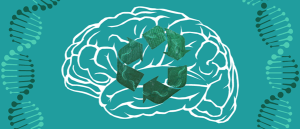
BioTechniques News
Beatrice Bowlby

Researchers identify a unique set of bacteria associated with Alzheimer’s, which could be involved in the pathogenesis of the disease.
The microbiome consists of trillions of microorganisms including bacteria, fungi, parasites and viruses. These are largely found in the gastrointestinal tract and coexist peacefully; however, when this community of microorganisms becomes imbalanced it can cause diseases including rheumatoid arthritis and bacterial vaginosis. Researchers at Drexel University College of Medicine (PA, USA) have found that the development of a pathogenic microbiome – or pathobiome – in the brain could play a role in Alzheimer’s or other related dementias.
Previous research has detected viruses, bacteria and fungi in the brains of those with Alzheimer’s disease, but many of these studies have focused on individual pathogens. Instead, the researchers of this study profiled the bacterial communities present in the brain. To do so, they used full-length 16s ribosomal RNA gene sequencing to detect bacterial species present in 130 brain samples donated from 32 individuals – 16 with Alzheimer’s and 16 age-matched controls. Samples were taken from the frontal and temporal lobes and the entorhinal cortex.
 Rare neurological disorder likely caused by insufficient cellular recycling
Rare neurological disorder likely caused by insufficient cellular recycling
A new study demonstrates how mutations in both copies of the gene responsible for cellular recycling, ATG4D, underlie a rare neurological disorder that affects motor coordination and speech.
They found that samples with Alzheimer’s had different bacterial profiles compared to the controls. They identified a set of bacteria present in almost all the Alzheimer’s-affected samples, indicating that these bacteria could be a predictor of the disease. These bacteria are also commonly found in amyotrophic lateral sclerosis (ALS), suggesting they may be involved in a variety of neurological illnesses.
Comamonas are bacteria associated with a dementia-free brain. The researchers found that the presence of pathogenic bacteria including Cutibacterium acnes, Methylobacterium, Bacillus, Caulobacter, Delftia and Variovora in the Alzheimer’s brain samples had overpowered and replaced Comamonas. “Perhaps the destruction of the Comamonas bacteria, part of a healthy brain microbiome, is the first sign of impending dementia,” said Garth Ehrlich, co-senior author. “We’re now coming up with the questions to guide future studies, but the hypotheses are many. The culprit could be bacteria or something else – like fungi, parasites, or viruses – at the same time.”
Five brain microbiomes were detected, four of which the researchers believe could be present at different stages of Alzheimer’s disease progression and evolve to become more pathogenic until it eventually becomes a pathobiome.
The ‘amyloid cascade hypothesis’ has been the main focus of Alzheimer’s research for decades, studying protein-oriented pathologies including tau protein tangles and Aβ peptide aggregation. Recent studies, such as this one, have challenged this model suggesting that pathogens, the immune system and brain inflammation play a role in Alzheimer’s disease. This is sometimes referred to as the ‘pathogen hypothesis’.
“Multiple studies have now shown the presence of bacteria in Alzheimer’s-afflicted brains,” explained Jeffrey Lapides, co-senior author. “Perhaps plaques, whose constituents have anti-microbial properties in vitro, aren’t the direct cause of Alzheimer’s, but instead are a response to bacteria in the brain – some benign, some pathogens, perhaps causing damage that has not yet resulted in cognitive deficits, making them part of the pathobiome.”
Next, research is needed to understand what is happening physiologically to cause the microbiome to change in the brain – is it due to a leaky blood–brain–barrier, the brain’s glymphatic system or synaptonemal transmission? The precise location of the bacteria needs to be obtained to better understand their role.
Ehrlich concluded, “there are many pathogens that likely increase the risk. The pathobiome is not the whole answer, but it’s a piece of the puzzle.”
The post The pathogen hypothesis: investigating the pathobiome of the Alzheimer’s-afflicted brain appeared first on BioTechniques.
Powered by WPeMatico
